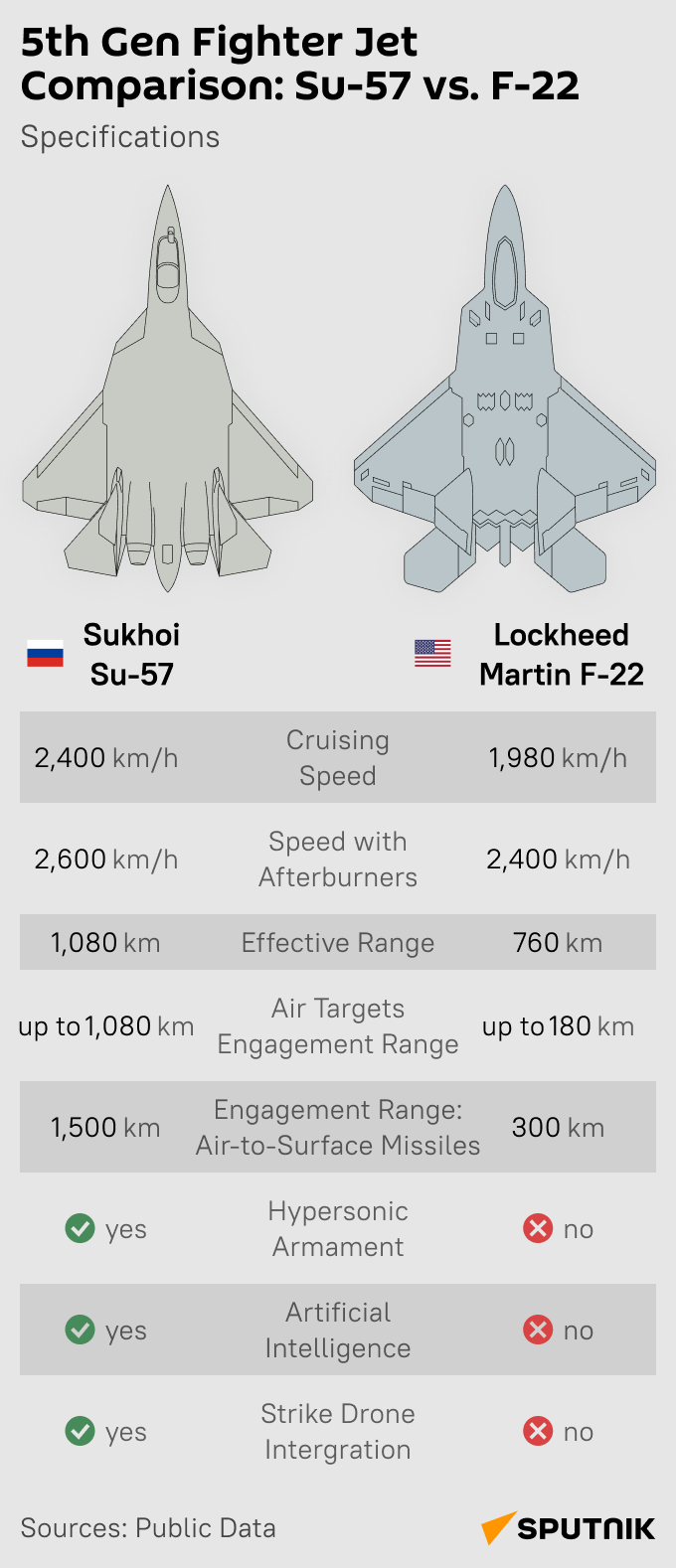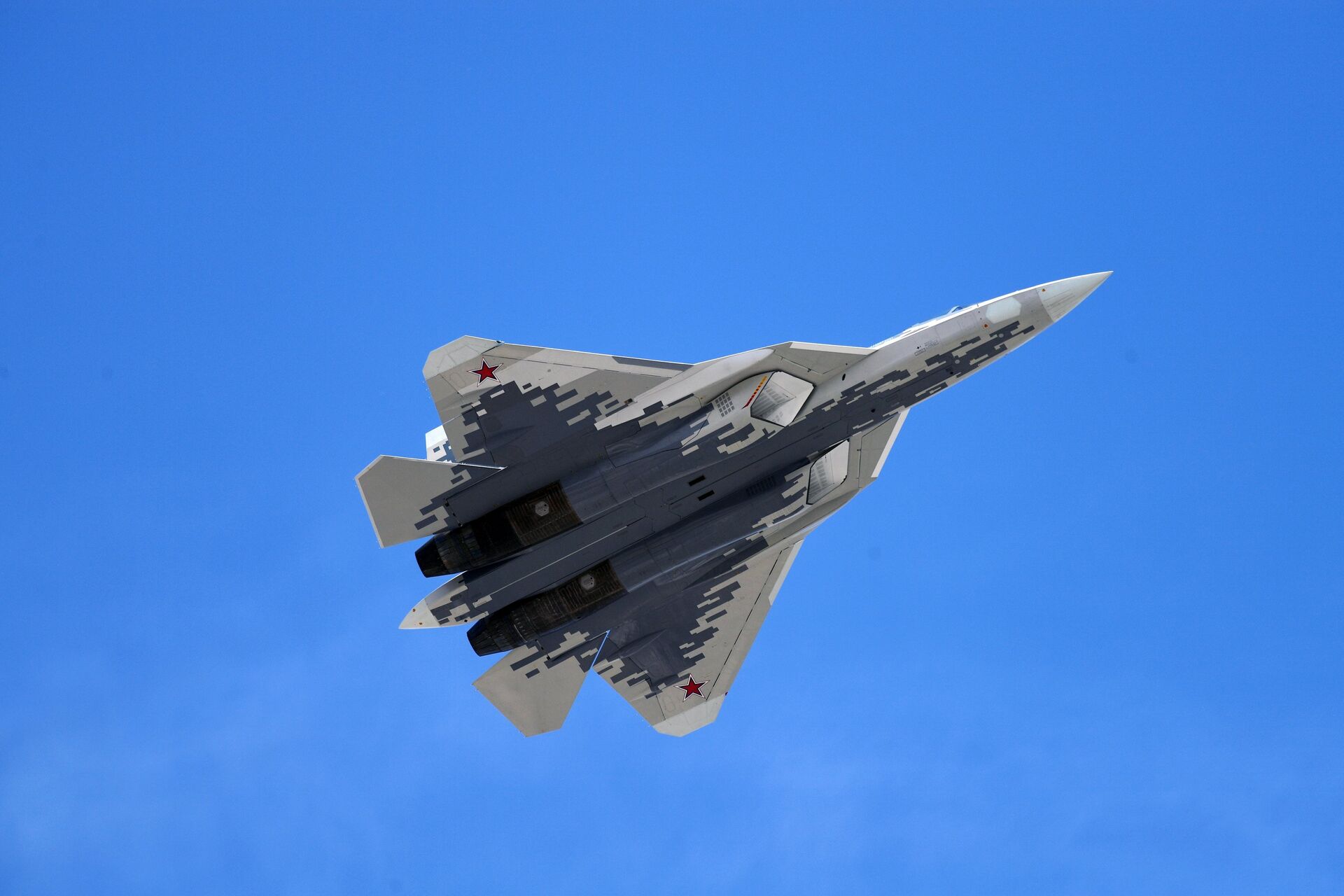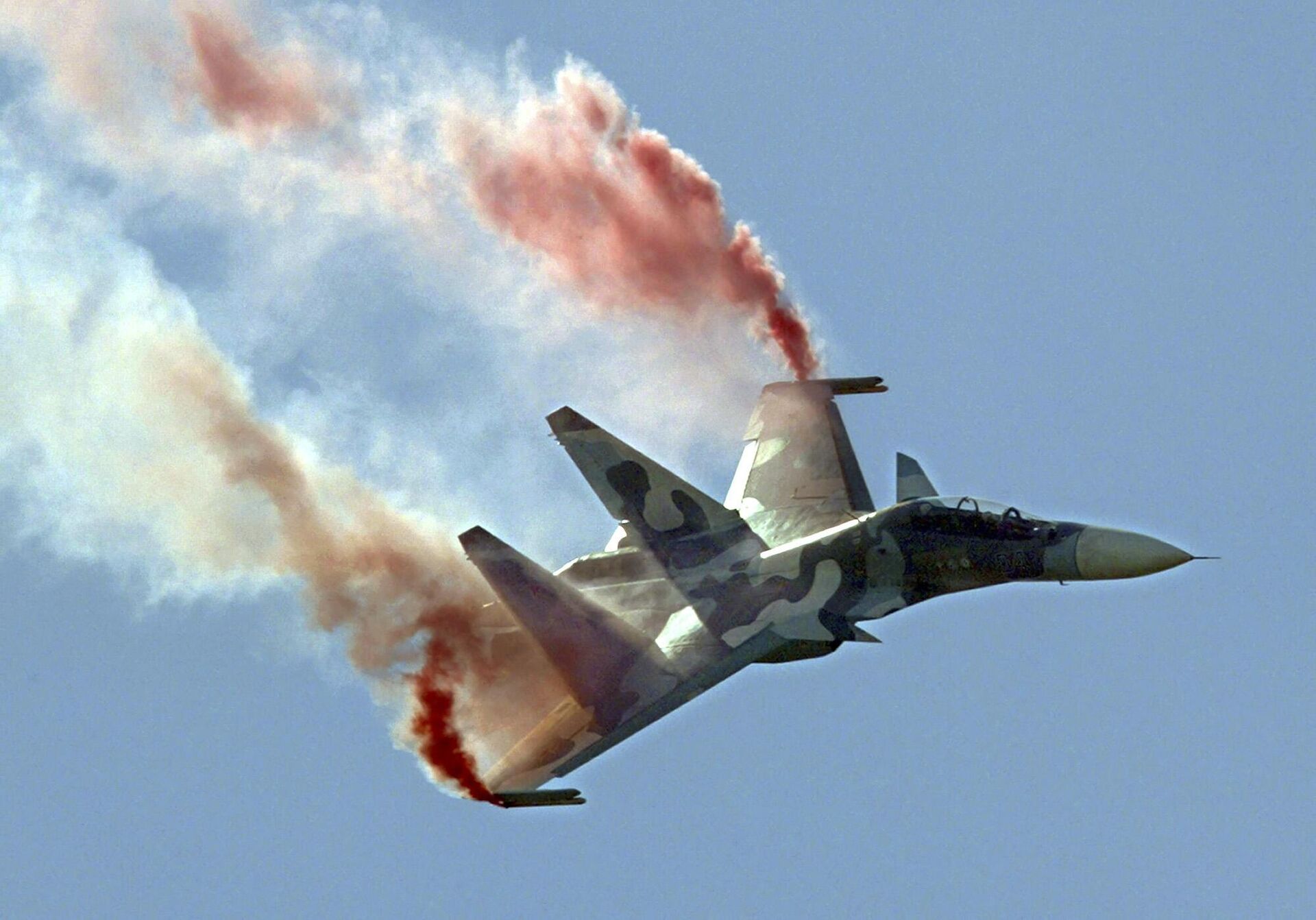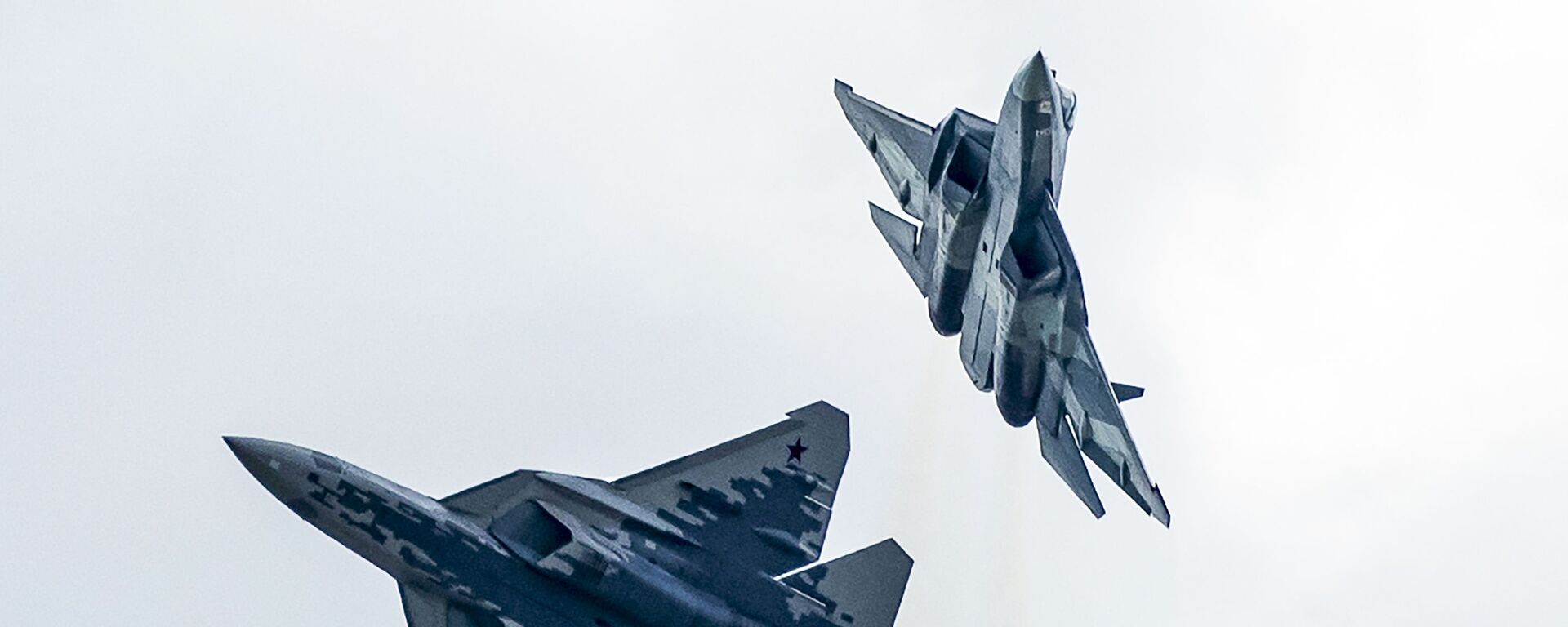https://sputniknews.in/20231121/game-changing-boost-to-su-57-capabilities-with-dual-seat-version-unveiled-5505982.html
Lethal Increase in Su-57 Capabilities Could Prompt IAF Relook
Lethal Increase in Su-57 Capabilities Could Prompt IAF Relook
Sputnik India
Russia continues to innovate on its cutting-edge 5th generation fighter aircraft. It is expected to become the mainstay of its Aerospace Forces in future.
2023-11-21T14:39+0530
2023-11-21T14:39+0530
2023-11-23T17:52+0530
defenсe news
russia
india
moscow
indian air force (iaf)
united aircraft corporation (uac)
mod russia
nirmala sitharaman
russian armed forces
russian aerospace forces
https://cdn1.img.sputniknews.in/img/07e7/0b/15/5506462_0:0:2961:1666_1920x0_80_0_0_c5f37619d4e228eb77b32a28f9d5299b.jpg
Russia's United Aircraft Corporation has published a patent for a Multifunctional two-seat stealth aircraft, which appears to be a variant of the fifth-generation heavy fighter, Su-57. Russian media, which have a copy of the patent, report that the two-seat stealth tactical aircraft is designed to detect and destroy air, surface and ground targets. New Variant Capabilities The document notes that the aircraft is designed to destroy targets with guided and unguided weapons. In other words the base aircraft retains its attack capability. However, it will be possible to use the new variant as an air control point with the ability to ensure interaction between aviation and military formations, as well as a control point for unmanned aerial vehicles.As per the document, the new Su-57 variant will feature increased range and duration. It will carry more fuel internally than the single seat variant, by utilising the additional space created by the redesign of the fuselage to accommodate a second seat. Optionally, it will also be able to carry additional fuel in tanks fitted into the weapon bays for internal carriage of missiles and bombs. The Dual Seat OptionIn June 2021, Russia's Deputy Prime Minister Yuri Borisov spoke about plans to create a dual seat variant of the Su-57 that would make the aircraft more versatile. Also, the aircraft would be more attractive to foreign customers, he said. Despite the complexity mandated by the versatility and advanced capabilities of the platform, the current Su-57 is designed for single seat operations. Situational awareness decision assist and automation have been extensively used to allow a single pilot to handle the cockpit workload. On August 9, 2021, media reported citing a source in the military-industrial complex that a modernised variant of the Su-57 is planned to begin production in 2025 within the framework of the Megapolis development work (ROC). He also clarified that the Su-57 fighter within the framework of the Megapolis ROC will be made in a single-seat version. (there has been no official confirmation of the information.) Earlier, media also reported that a two-seater Su-57 is being developed to control the promising Okhotnik (S-70) combat drone. Benefits of Dual Seat Variant An obvious benefit from creating a dual seat version of the fighter would be the ease of training new pilots. However, as operational tasks assigned to the stealth fighter get increasingly complex, there will arise a need for a second pilot. For example, if the aircraft is operating as a drone mothership or operating with weapon truck aircraft. In the case of the former, a twin seat Su-57 could operate with one or more highly stealthy S-70 Okhotnik (Hunter) combat drones. The drones would penetrate deep into contested airspace to obtain and relay targeting information on air or ground targets to the Su-57 drone mothership. The Su-57 would then launch long range missiles, including hypersonic missiles, in its internal weapons bay to destroy the targets. The manned Su-57 would thus be able to accomplish its task without any risk to the aircraft or pilot. In the case of the latter, the dual seat Su-57 would be configured for high stealth and endurance. It would penetrate contested airspace undetected to obtain targeting information and relay it to non stealthy weapon truck aircraft operating outside adversary air defence range. The weapon trucks would then engage the targets using long range missiles. Cooperative Combat ExerciseOn June 28, 2020, media reported that Russia had tested Su-35 - Su-57 cooperative operations. The Su-35 likely role played weapon trucks with standoff precision guided munitions (PGMs), operating in uncontested airspace, while the Su-57 operated as a penetrating sensor in contested airspace, relaying targeting information over data links. The presence of a second pilot will facilitate the use of advanced electronic and computing facilities required to support the use of the Su-57 with Okhotnik drones or weapon truck aircraft like the Su-30SM and Su-35S.Foreign Interest It's interesting to note that the Fifth Generation Fighter Aircraft (FGFA) that was proposed to be co-developed by India and Russia was a two seat variant of the Su-57 fighter. India opted out of the project on the grounds that the aircraft lacked essential 5th generation features such as supercruise, and was not stealthy enough. The IAF was sceptical of the operational effectiveness of the aircraft. In February 2017, a panel headed by a senior retired IAF officer was convened by the Indian government to examine different aspects of the FGFA project and the technology it brings into the country. In July 2017, the panel submitted its report to the MoD stating that the FGFA project would be beneficial to India. It is also worth noting that while India suspended its participation in the FGFA, it kept open its option to acquire the aircraft at a later date. In July 2019, India's Chief of Air Staff, Air Chief Marshal Birender Singh Dhanoa, said in an interview with the Russian Armed Forces' official newspaper, Krasnaya Zvezda, that India would make a decision on the Su-57 jet after seeing it in action in Russia, and after Moscow presents the new aircraft in New Delhi. Russia has operationally deployed the Su-57 and its performance has been creditable, going by reports in the Russian and Western media. As to supercruise, Russia's second stage (5th gen) engine for the Su-57, referred to as Izdeliye 30, is currently being flight tested on the fighter. Aircraft supplied till the mid-2020s would be powered by an interim (4th gen) engine. Those delivered from the mid-2020s would be powered by the second stage (5th gen) engine. Conclusion With the Su-57, Russia appears to be following the same approach that the Soviet Union successfully pursued after developing the Su-27 - of continuously reinventing the aircraft to meet the challenges and opportunities emerging from technological advances. The Su-27, which was officially inducted into the Soviet Air Force in 1985, evolved into several Su-30 variants, Su-34, Su-35 and J-11, all of which remain in service till date. The evolved variants of the Su-27 will likely remain in service for at least a couple of decades more. It's highly likely that Su-57 variants will similarly remain in service for the next 50 years. Russia has tested the Su-57s swarm operation abilities with the Su-35S;The IAF could leverage the ability as a force multiplier for its fleet of upgraded Su-30MKIs.The new variant of the Su-57 is not a distant dream. Russia could operationally deploy it as early as 2026. Its futuristic capabilities easily eclipse what the US, France or Europe could offer to us under MRFA or any other program.And if it's germane, India's involvement in the FGFA, which never ended, predates CAATSA.
https://sputniknews.in/20231118/india-uae-joint-production-of-russias-su-57--would-reduce-us-mideast-influence-expert-5471728.html
russia
india
moscow
Sputnik India
feedback.hindi@sputniknews.com
+74956456601
MIA „Rossiya Segodnya“
2023
News
en_IN
Sputnik India
feedback.hindi@sputniknews.com
+74956456601
MIA „Rossiya Segodnya“
Sputnik India
feedback.hindi@sputniknews.com
+74956456601
MIA „Rossiya Segodnya“
russia, united aircraft corporation, patent, multifunctional two-seat stealth aircraft, variant, fifth-generation heavy fighter, su-57, tass, copy, two-seat stealth tactical aircraft, detect, destroy, air, surface, ground targets.new variant capabilities, patent document, aviation, multifunctional two-seat stealth tactical aircraft, detect, destroy, air, surface, ground targets, super, subsonic flight speeds, wide range of altitudes, airborne command post, network-oriented actions, mixed groups of aircraft.the su-57 dual seat option, june 2021, russia, deputy prime minister yuri borisov, dual seat variant, su-57, versatile, attractive, foreign customers, complexity, single seat operations, situational awareness decision assist, automation, single pilot, cockpit workload.benefits of dual seat variant, training new pilots, operational tasks, stealth fighter, second pilot, drone mothership, weapon truck aircraft, advanced electronic, computing facilities, su-35 - su-57 cooperative operations, experiment, real combat conditions.foreign interest, fifth generation fighter aircraft (fgfa), co-developed, india, russia, two seat variant, su-57 fighter, india's defence minister nirmala sitharaman, option, acquire, aircraft, later date, chief of air staff, air chief marshal birender singh dhanoa, decision, su-57 jet, in action, russia, moscow presents, new aircraft.conclusion, su-57, russia, soviet union, reinventing, aircraft, su-27, continuously, meet challenges, opportunities, technological advances, su-27, officially inducted, soviet air force, 1985, su-30 variants, su-34, su-35, j-11, service, evolved variants, next 50 years, additional fuel, weapons bays, interesting innovation, versatility, stealth fighter, drone mothership, penetrating sensor, adversary airspace, contested.
russia, united aircraft corporation, patent, multifunctional two-seat stealth aircraft, variant, fifth-generation heavy fighter, su-57, tass, copy, two-seat stealth tactical aircraft, detect, destroy, air, surface, ground targets.new variant capabilities, patent document, aviation, multifunctional two-seat stealth tactical aircraft, detect, destroy, air, surface, ground targets, super, subsonic flight speeds, wide range of altitudes, airborne command post, network-oriented actions, mixed groups of aircraft.the su-57 dual seat option, june 2021, russia, deputy prime minister yuri borisov, dual seat variant, su-57, versatile, attractive, foreign customers, complexity, single seat operations, situational awareness decision assist, automation, single pilot, cockpit workload.benefits of dual seat variant, training new pilots, operational tasks, stealth fighter, second pilot, drone mothership, weapon truck aircraft, advanced electronic, computing facilities, su-35 - su-57 cooperative operations, experiment, real combat conditions.foreign interest, fifth generation fighter aircraft (fgfa), co-developed, india, russia, two seat variant, su-57 fighter, india's defence minister nirmala sitharaman, option, acquire, aircraft, later date, chief of air staff, air chief marshal birender singh dhanoa, decision, su-57 jet, in action, russia, moscow presents, new aircraft.conclusion, su-57, russia, soviet union, reinventing, aircraft, su-27, continuously, meet challenges, opportunities, technological advances, su-27, officially inducted, soviet air force, 1985, su-30 variants, su-34, su-35, j-11, service, evolved variants, next 50 years, additional fuel, weapons bays, interesting innovation, versatility, stealth fighter, drone mothership, penetrating sensor, adversary airspace, contested.
Russia's United Aircraft Corporation has published a patent for a Multifunctional two-seat stealth aircraft, which appears to be a variant of the fifth-generation heavy fighter, Su-57.
Russian media, which have a copy of the patent, report that the two-seat stealth tactical aircraft is designed to detect and destroy air, surface and ground targets.
The patent document states, "the invention relates to the field of aviation, namely to multifunctional two-seat stealth tactical aircraft, and is intended to detect and destroy air, surface and ground targets at super and subsonic flight speeds in a wide range of altitudes, as well as acting as an airborne command post for network-oriented actions of mixed groups of aircraft."
The document notes that the aircraft is designed to destroy targets with guided and unguided weapons. In other words the base aircraft retains its
attack capability.
However, it will be possible to use the new variant as an air control point with the ability to ensure interaction between aviation and military formations, as well as a control point for
unmanned aerial vehicles.
As per the document, the new
Su-57 variant will feature increased range and duration. It will carry more fuel internally than the single seat variant, by utilising the additional space created by the redesign of the fuselage to accommodate a second seat.
Optionally, it will also be able to carry additional fuel in tanks fitted into the
weapon bays for internal carriage of missiles and bombs.
In June 2021, Russia's Deputy Prime Minister Yuri Borisov spoke about plans to create a dual seat variant of the Su-57 that would make the aircraft more versatile. Also, the aircraft would be more
attractive to foreign customers, he said.
Despite the complexity mandated by the versatility and advanced capabilities of the platform, the current Su-57 is designed for single seat operations. Situational awareness decision assist and automation have been extensively used to allow a single pilot to handle the cockpit workload.
On August 9, 2021, media reported citing a source in the
military-industrial complex that a modernised variant of the Su-57 is planned to begin production in 2025 within the framework of the Megapolis development work (ROC).
"In the updated version of the fighter within the framework of the Megapolis ROC, a completely updated cockpit with the most advanced avionics will be installed. In addition, the aircraft will be equipped with a second stage power plant," said the interlocutor of the agency.
He also clarified that the Su-57 fighter within the framework of the Megapolis ROC will be made in a single-seat version. (there has been no official confirmation of the information.)
Earlier, media also reported that a two-seater Su-57 is being developed to control the promising Okhotnik (S-70)
combat drone.
Benefits of Dual Seat Variant
An obvious benefit from creating a dual seat version of the fighter would be the ease of training new pilots.
However, as
operational tasks assigned to the stealth fighter get increasingly complex, there will arise a need for a second pilot. For example, if the aircraft is operating as a drone mothership or operating with weapon truck aircraft.
In the case of the former, a twin seat Su-57 could operate with one or more highly stealthy S-70 Okhotnik (Hunter) combat drones. The drones would penetrate deep into contested airspace to obtain and relay targeting information on air or ground targets to the Su-57 drone mothership. The Su-57 would then launch long range missiles, including
hypersonic missiles, in its internal weapons bay to destroy the targets. The manned Su-57 would thus be able to accomplish its task without any risk to the aircraft or pilot.
In the case of the latter, the dual seat Su-57 would be configured for high stealth and endurance. It would penetrate contested airspace undetected to obtain targeting information and relay it to non stealthy weapon truck aircraft operating outside adversary air defence range. The weapon trucks would then
engage the targets using long range missiles.
Cooperative Combat Exercise
On June 28, 2020, media reported that Russia had tested Su-35 - Su-57 cooperative operations.
"The experiment was carried out in real combat conditions, a group of Su-35 fighters was involved in the 'flock,' the role of the command and staff aircraft was performed by the Su-57," a source told Russian media.
The Su-35 likely role played weapon trucks with standoff
precision guided munitions (PGMs), operating in uncontested airspace, while the Su-57 operated as a penetrating sensor in contested airspace, relaying targeting information over data links.
The presence of a second pilot will facilitate the use of advanced electronic and computing facilities required to support the use of the Su-57 with Okhotnik drones or weapon truck aircraft like the Su-30SM and Su-35S.
It's interesting to note that the Fifth Generation Fighter Aircraft (FGFA) that was proposed to be co-developed by India and Russia was a two seat variant of the Su-57 fighter.
India opted out of the project on the grounds that the aircraft lacked essential 5th
generation features such as supercruise, and was not stealthy enough. The IAF was sceptical of the operational effectiveness of the aircraft.
In February 2017, a panel headed by a senior retired IAF officer was convened by the Indian government to examine different aspects of the FGFA project and the technology it brings into the country. In July 2017, the panel submitted its report to the MoD stating that the FGFA project would be beneficial to India.
It is also worth noting that while India suspended its participation in the FGFA, it
kept open its option to acquire the aircraft at a later date.
In July 2018, India's Defence Minister Nirmala Sitharaman told Business standard, “In February, it was conveyed to the Russians that they could go ahead with developing the fighter without us. But the option remains and we could well go back at a later stage and ask to buy the fighter.”
In July 2019, India's Chief of Air Staff, Air Chief Marshal Birender Singh Dhanoa, said in an interview with the
Russian Armed Forces' official newspaper, Krasnaya Zvezda, that India would make a decision on the Su-57 jet after seeing it in action in Russia, and after Moscow presents the new aircraft in New Delhi.
Russia has operationally deployed the Su-57 and its
performance has been creditable, going by reports in the Russian and Western media. As to supercruise, Russia's second stage (5th gen) engine for the Su-57, referred to as Izdeliye 30, is currently being flight tested on the fighter. Aircraft supplied till the mid-2020s would be powered by an interim (4th gen) engine. Those delivered from the mid-2020s would be powered by the second stage (5th gen) engine.
With the Su-57, Russia appears to be following the same approach that the Soviet Union successfully pursued after developing the Su-27 - of continuously reinventing the aircraft to meet the challenges and opportunities emerging from
technological advances.
The Su-27, which was officially inducted into the Soviet Air Force in 1985, evolved into several Su-30 variants, Su-34, Su-35 and J-11, all of which remain in service till date. The evolved variants of the Su-27 will likely remain in service for at least a couple of decades more.
It's highly likely that Su-57 variants will similarly remain in service for the next 50 years.
The lethal increase in Su-57 capabilities, accruing from the addition of a second cockpit, should be hard to ignore for the IAF. Conceptually, in many ways, the new Su-57 variant may be compared to the US B-21 raider. The new Su-57 variant would be significantly less capable but much more affordable and practical. Indian adversaries are across India's land borders, not across vast oceans! As such, the IAF has neither the need for the B-21's very long operational range, nor its high quality stealth based deep penetration. The Su-57, armed with its new generation weapons, has the range and stealth to hit our adversaries end to end.
Russia has tested the Su-57s swarm operation abilities with the Su-35S;
The IAF could leverage the ability as a force multiplier for its fleet of upgraded Su-30MKIs.
The new variant of the Su-57 is not a distant dream. Russia could operationally deploy it as early as 2026. Its futuristic capabilities easily eclipse what the US, France or Europe could offer to us under MRFA or any other program.
And if it's germane, India's involvement in the FGFA, which never ended, predates CAATSA.






